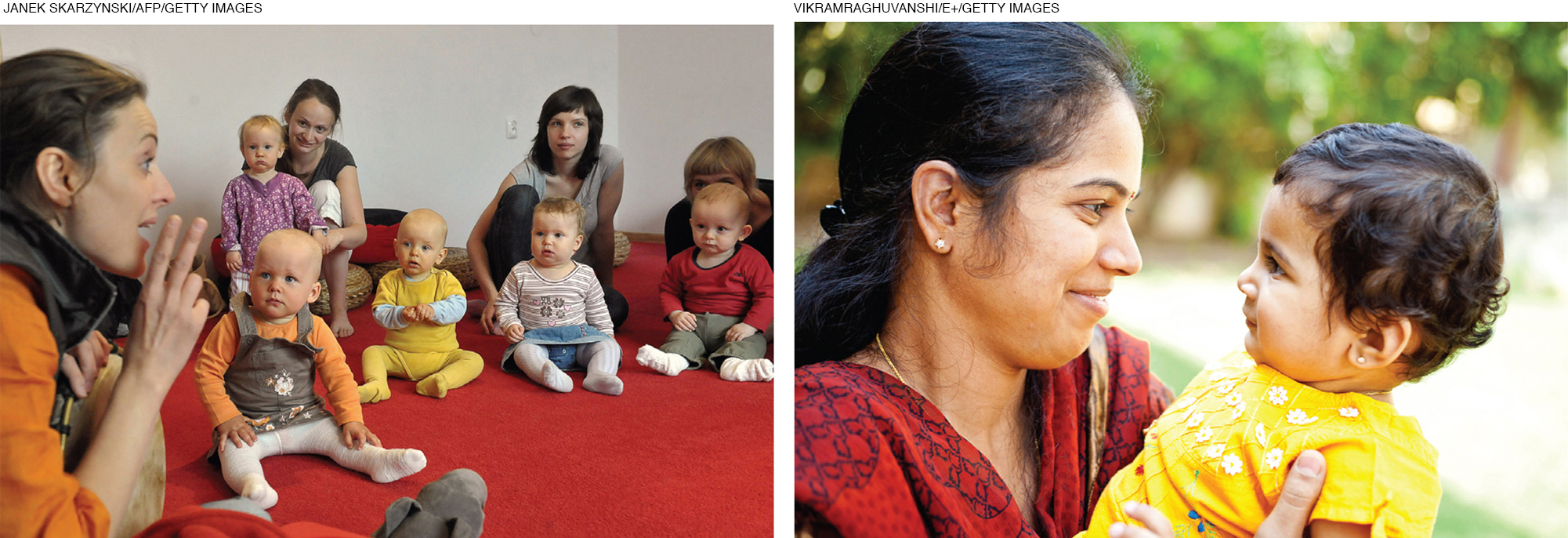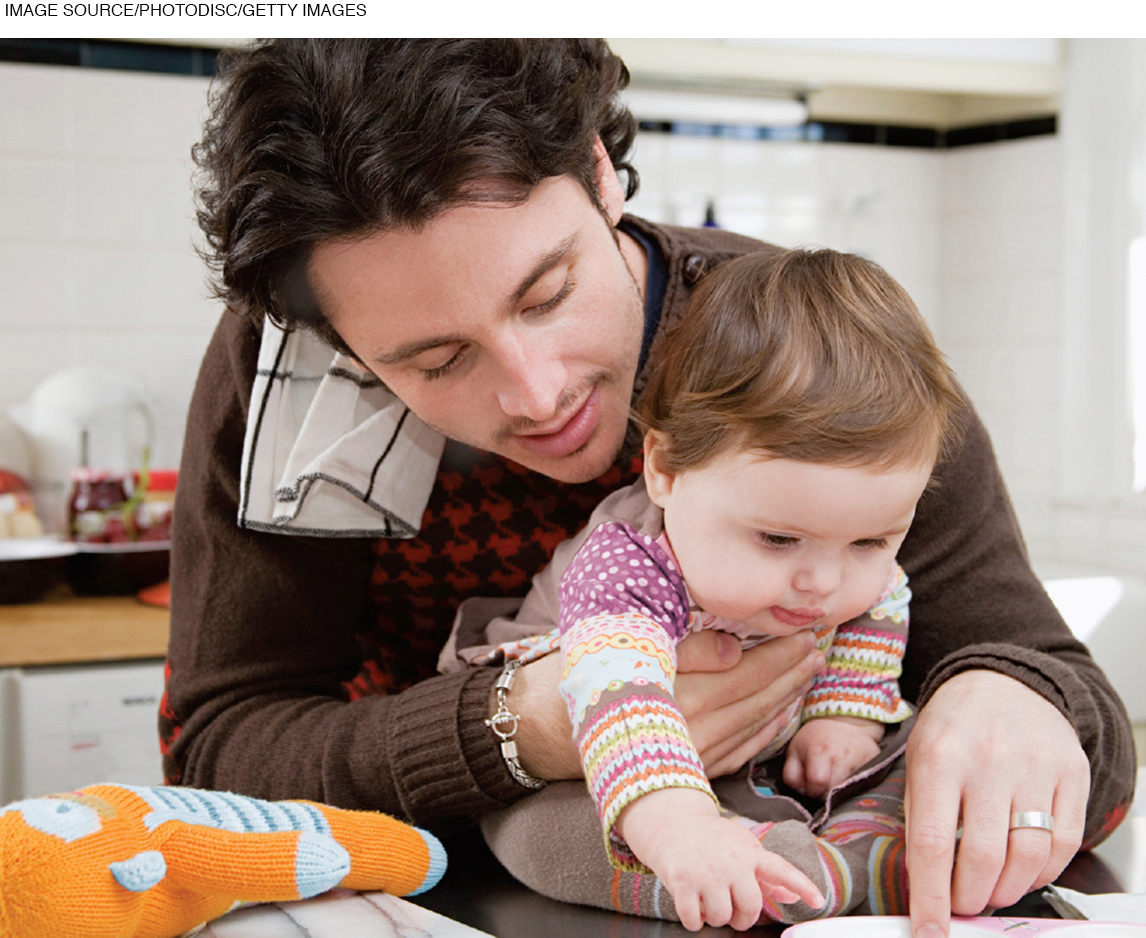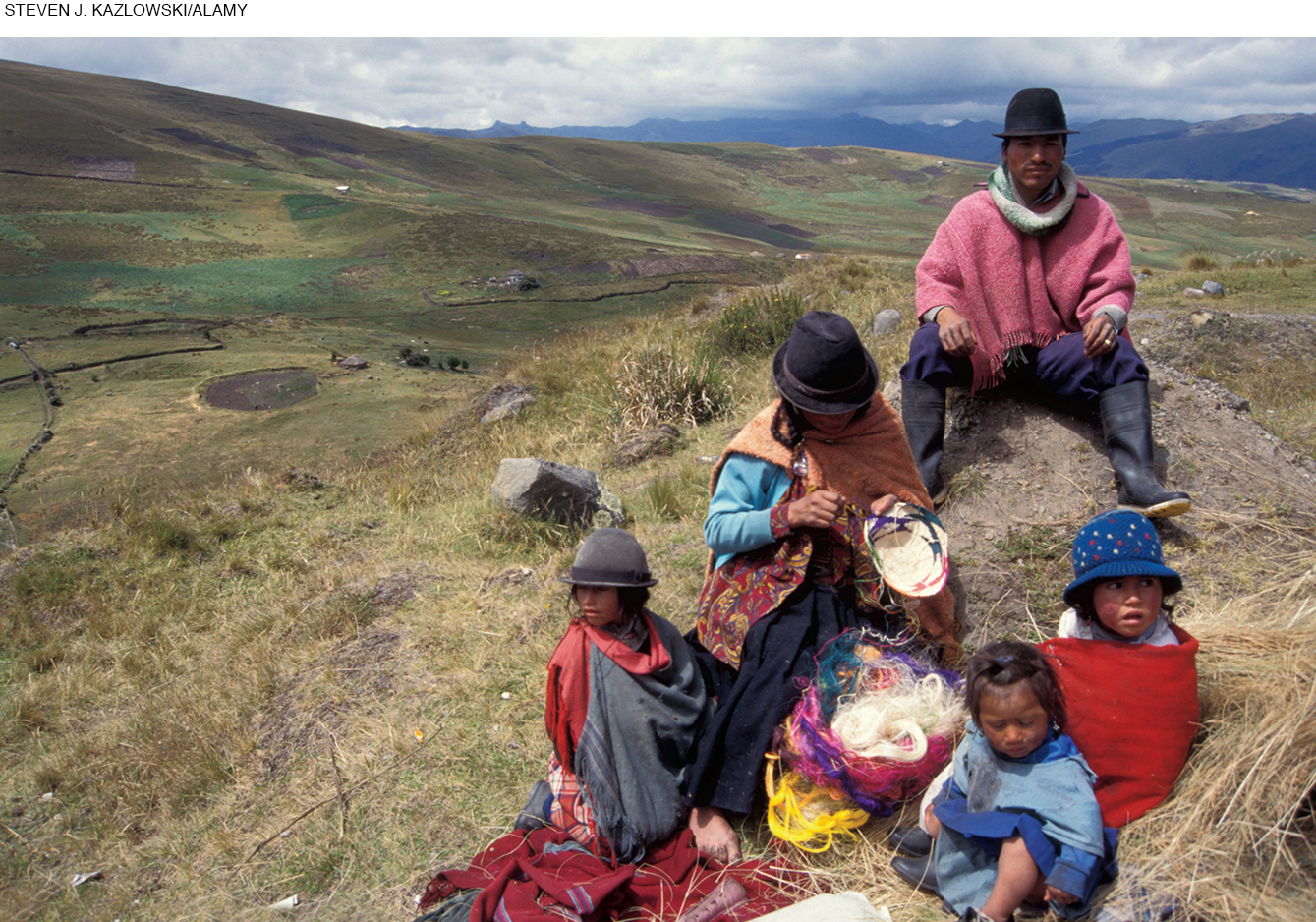Language
No other species has anything approaching the neurons and networks that support the 6,000 or so human languages. The human ability to communicate, even at age 2, far surpasses that of full-
Here we describe the beginning of language learning, “from burping to grammar” as one scholar put it (Saxton, 2010, p. 2). Before age 1, babies listen intensely, “acquiring much of their native language before they utter their first word” (Aslin, 2012, p. 191).
The Universal Sequence
The timing of language acquisition varies; the most advanced 10 percent of 2-
LISTENING AND RESPONDING Hearing infants begin learning language before birth, via brain connections. Newborns prefer the language their mother speaks over an unheard language; if their mother is bilingual, newborns respond to both languages (Byers-
The ability to distinguish sounds, mouth movements, and gestures in the language (or languages) of caregivers improves over the first year, while the ability to decipher sounds in an unfamiliar language deteriorates (Narayan et al., 2010). By 1 year, babies are more likely to imitate the actions of a stranger speaking their native tongue than those of a person who speaks another language (Buttelmann et al., 2013).
Early language learning is encouraged everywhere by adults who instinctively use higher pitch, simpler words, repetition, varied speeds, and exaggerated emotional tones when they talk to babies (Bryant & Barrett, 2007). This special language form is sometimes called baby talk and sometimes called motherese, since mothers universally speak it.
child-
The high-
Both these terms may be misleading, since people use that form with lovers as well as babies, and since many nonmothers use it as well. Scientists prefer a more formal designation: child-
Sounds are preferred over content. Infants like alliteration, rhymes, repetition, rhythm, and varied pitch (Hayes & Slater, 2008; Saxton, 2010; Schön et al., 2008). Think of your favorite lullaby (itself an alliterative word). All infants listen to whatever they can and appreciate the sounds they hear. Even music is culture-
| Age* | Means of Communication |
|---|---|
| Newborn | Reflexive communication— |
| 2 months | A range of meaningful noises— |
| 3– |
New sounds, including squeals, growls, croons, trills, vowel sounds. |
| 6– |
Babbling, repeating both consonant and vowel sounds. |
| 10– |
Comprehension of simple words; speech- |
| 12 months | First spoken words that are recognizably part of the native language. |
| 13– |
Slow growth of vocabulary, up to about 50 words. |
| 18 months | Naming explosion— |
| 21 months | First two- |
| 24 months | Multiword sentences. Half the toddler’s utterances are two or more words long. |
*The ages in this table reflect norms. Many healthy, intelligent children attain each linguistic accomplishment earlier or later than indicated here.

babbling
The extended repetition of certain syllables, such as ba-
BABBLING At first, babies mostly listen. By 6 months, they start practicing sounds, repeating certain syllables (ma-
Toward the end of the first year, babbling begins to sound like the infant’s native language; infants imitate what they hear in accents, cadence, consonants, and so on. Gestures also become more specific as a means of communication.
Consider pointing, an amazing example of social perspective. Most animals cannot interpret pointing; most 10-
FIRST WORDS Finally, the average hearing baby utters a few words, usually at about 12 months, although the range for normal babies is 10–
holophrase
A single word that is used to express a complete, meaningful thought.
However, 6-
naming explosion
A sudden increase in an infant’s vocabulary, especially in the number of nouns, that begins at about 18 months of age.
VERBS AND NOUNS Once vocabulary reaches about 50 expressed words (understood words are far more extensive), it builds rapidly, at a rate of 50 to 100 words per month, with 21-
Early sequence and uttered sounds are universal, but differences soon emerge. For instance, about 30 languages of the world use a click sound as part of the spoken words; infants in those communities become adept at clicking. Similarly, the rolled r, the enunciated l or th, the difference between b and v are mastered by infants in some languages but not others, depending on what they hear.
Although all new talkers say more nouns than any other parts of speech, the ratio of nouns to verbs varies from place to place. For example, by 18 months, English-
One explanation goes back to the language itself. Mandarin, Cantonese, and Korean are “verb-
An alternative explanation considers the social context: Playing with a variety of toys and learning about dozens of objects are crucial in North American culture, whereas East Asian cultures emphasize human interactions—
Accordingly, North American infants are expected to name many objects, whereas Asian infants are expected to act on objects and respond to people. Thus, toddlers within China might learn the equivalent of come, play, love, carry, run, and so on earlier than toddlers elsewhere.
A simpler explanation is that young children are sensitive to the sounds of words, with some sounds more salient than others. The infant preference for sounds may be one reason why many English-

Verbs are learned more easily if they sound like the action (Imai et al., 2008), and such verbs may be more common in some languages than others. In English, most verbs are not onomatopoeic, although perhaps jump, kiss, and poop—all learned relatively early in life—
grammar
All the methods—
PUTTING WORDS TOGETHER Grammar can be defined as including all the methods that languages use to communicate meaning. Word order, prefixes, suffixes, intonation, verb forms, pronouns and negations, prepositions and articles—
Grammar can be discerned in holophrases but becomes obvious between 18 and 24 months, when two-
Soon the child combines three words, usually in subject–
mean length of utterance (MLU)
The average number of meaningful sound combination in a typical sentence (called utterance, because children may not use conventional words). MLU is often used to indicate a child’s language development.
Children’s proficiency in grammar correlates with the length of their sentences, which is why in every language mean length of utterance (MLU) is considered an accurate way to measure a child’s language progress (e.g., Miyata et al., 2013). The child who says “Baby is crying” is advanced compared with the child who says “Baby cry” or simply the holophrase “Baby.”
Careful tracing of early language from the information-
This slowdown before a language spurt is not evident in every infant, but many seem temporarily quieter before uttering a string of new words (Parladé & Iverson, 2011). Those who talk relatively late sometimes put two words together almost as soon as they speak their first holophrase.
How Do They Do It?
Worldwide, people who are not yet 2 years old already speak their native tongue. They continue to learn rapidly: Some teenagers compose lyrics or deliver orations that move thousands of their co-
THEORY ONE: INFANTS NEED TO BE TAUGHT The seeds of the first perspective were planted more than 50 years ago, when the dominant theory in North American psychology was behaviorism, or learning theory (see Chapter 1). The essential idea was that all learning is acquired, step by step, through association and reinforcement.
B. F. Skinner (1957) noticed that spontaneous babbling is usually reinforced. Typically, every time the baby says “ma-
Behaviorists note that some 3-
Parents of the most verbal children teach language throughout infancy—
THEORY TWO: SOCIAL INTERACTION FOSTERS INFANT LANGUAGE The second theory arises from the sociocultural reason for language: communication. According to this perspective, infants communicate because humans have evolved as social beings, dependent on one another for survival and joy. Language is designed to further social communication.
It is the emotional messages of speech, not the words, that are the focus of early communication, according to this perspective. The social content of speech is universal, which is why babies learn whatever particular grammar their culture provides.
One study that illustrated this began with Shuar hunter-
This theory contends that all infants (and no chimpanzees) master words and grammar because they are powerfully driven to join the social world in which they find themselves (Tomasello & Herrmann, 2010). Cultures vary in how they communicate—
THINK CRITICALLY: Besides using spoken words, how else do humans communicate?
A behaviorist might consider the quieter, less verbal child to be developmentally delayed, but this second perspective contends that the crucial aspect of language is social communication. The quieter child may simply be communicating in another way.
THEORY THREE: INFANTS TEACH THEMSELVES A third theory holds that language learning is innate; adults need not teach it, nor is it a by-
The seeds of this perspective were planted soon after Skinner proposed his theory of verbal learning. Noam Chomsky (1968, 1980) and his followers felt that language is too complex to be mastered merely through step-

Noting that all young children master basic grammar at about the same age, Chomsky cited this universal grammar as evidence that humans are born with a mental structure that prepares them to seek some elements of human language—
language acquisition device (LAD)
Chomsky’s term for a hypothesized mental structure that enables humans to learn language, including the basic aspects of grammar, vocabulary, and intonation.
Chomsky labeled this hypothesized mental structure the language acquisition device (LAD), which enables children to derive the rules of grammar quickly and effectively from the speech they hear every day, regardless of whether their native language is English, Arabic, or Urdu. The social, cooperative habits of Homo sapiens 100,000 years ago allowed survival of the species, so evolution led to language. That is evident in every human infant.
Other scholars agree with Chomsky that infants are innately ready to use their minds to understand and speak whatever language is offered. All babies are eager learners, and language may be considered one more aspect of neurological maturation (Wagner & Lakusta, 2009), experience-
This idea does not strip languages and cultures of their differences in sounds, grammar, and almost everything else. Chomsky called those “surface” language. However, the basic idea is that “language is a window into human nature, exposing deep and universal features of our thoughts and feelings” (Pinker, 2007, p. 148). We all want to look out that window.
Research supports this perspective as well. As you remember, newborns are primed to listen to speech (Vouloumanos & Werker, 2007), and all infants babble ma-
ALL TRUE? Which of these three perspectives is correct? Perhaps all of them.
Infants use language in many ways—
Current thinking is that children are not exclusively behaviorists, social learners, or innately driven, but all three. Learning a new word or grammar form is not an all-
Some scholars, inspired by evolutionary theory, think that language is the crucial trait that makes humans unlike any other species—
Adults need to talk often to infants (theory one), encourage social connections (theory two), and appreciate the innate abilities of the child (theory three). As one expert concludes:
In the current view, our best hope for unraveling some of the mysteries of language acquisition rests with approaches that incorporate multiple factors, that is, with approaches that incorporate not only some explicit linguistic model, but also the full range of biological, cultural, and psycholinguistic processes involved.
[Tomasello, 2006, pp. 292–
The idea that every theory is correct in some way may seem uncritical, naive, and idealistic. However, a similar conclusion was arrived at by scientists extending and interpreting research on language acquisition. They contend that language learning is neither the direct product of repeated input (behaviorism) nor the result of a specific human neurological capacity (LAD).
Rather, “different elements of the language apparatus may have evolved in different ways,” and thus a “piecemeal and empirical” approach is needed (Marcus & Rabagliati, 2009, p. 281). In other words, no single theory explains how babies learn language.
An analogy can be made to other aspects of body and brain growth. Every newborn needs extensive care for years, but parents use diverse methods of child care, adjusting to their culture as well as to the particular needs of their baby at the moment. The result is children who become capable adults, walking, talking and contributing to their community. Diversity is evident, as are universals. The next chapter continues that theme.
WHAT HAVE YOU LEARNED?
Question 3.31
1. What aspects of language develop in the first year?
By 6 months, babies start practicing sounds, repeating certain syllables in a phenomenon called babbling. Toward the end of the first year, babbling begins to sound like the infant’s native language; infants imitate what they hear in accents, cadence, consonants, and so on. Gestures also become more specific as a means of communication.
Question 3.32
2. When does vocabulary develop slowly and when does it develop quickly?
Growth of vocabulary is slow for 13-
Question 3.33
3. What are the characteristics of the way adults talk to babies?
Adults everywhere use higher pitch, simpler words, repetition, varied speeds, and exaggerated emotional tones when they speak to infants. This is known as child-
Question 3.34
4. How would a caregiver who subscribes to the behaviorist theory of language learning respond when an infant babbles?
A behaviorist would respond to babbling with gestures and sounds, thus reinforcing speech.
Question 3.35
5. What is typical of the first words that infants speak?
The average hearing baby utters a few words, usually at about 12 months, although the range for normal babies is 10–
Question 3.36
6. What indicates that toddlers use some grammar?
When infants start using two-
Question 3.37
7. According to behaviorism, how do adults teach infants to talk?
Skinner believed that most parents are excellent instructors, replying to their infants’ gestures and sounds, thus reinforcing speech. According to behaviorists, if adults want children who speak, understand, and read well, they must talk and read to their infants.
Question 3.38
8. According to sociocultural theory, why do infants try to communicate?
According to sociocultural theory, infants communicate because humans have evolved as social beings, dependent on one another for survival and joy. Each culture has practices that further social interaction; talking is one of those practices.
Question 3.39
9. Do people really have a language acquisition device?
Though hypothesized, many scholars agree with Chomsky that an LAD enables children to derive the rules of grammar quickly and effectively from the speech they hear every day, regardless of dialect. Others believe that no single theory explains how babies learn language.
Question 3.40
10. Why do developmentalists accept several theories of language development?
Current thinking is that children are not exclusively behaviorists, social learners, or innately driven, but all three. Some scholars, inspired by evolutionary theory, think that language is the crucial trait that makes humans unlike any other species—